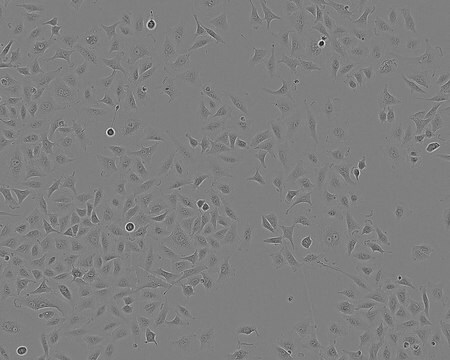3T3 L1 Cell Line from mouse
NOTE: Both the cell line and DNA from the cell line may be available for this product. Please choose -1VL or VIAL for cells, or -DNA-5UG for DNA, 86052701, mouse embryo, Fibroblast-like
Sinónimos:
3T3L1 Cells, NIH-3T3-L1 Cells, NIH3T3-L1 Cells
About This Item
Productos recomendados
biological source
mouse embryo
description
embryo
packaging
tube of 5 μg 86052701-DNA-5UG
pkg of vial of cells 86052701-1VL
growth mode
Adherent
karyotype
2n = 40; Aneuploid with unstable karyotype
morphology
Fibroblast-like
products
Not specified
receptors
Not specified
technique(s)
cell culture | mammalian: suitable
shipped in
dry ice
storage temp.
−196°C
Cell Line Origin
Cell Line Description
We would like to manage customer expectations with regard to the potential of the current 3T3 cell line stocks to differentiate into adipocytes. If you intend to use the cells for adipocyte differentiation please note: When cells are stimulated, using an appropriate protocol, differentiation may take several weeks to occur, e.g. 2 - 5 weeks, and the proportion of the population which differentiates can be limited. If you have previously used 3T3 cells from an alternative source we cannot guarantee the differentiation performance will be the same.
We are working to source a new stock of this cell line that has a higher rate of adipocyte differentiation potential which we aim to be able to offer in the future. When this is available we will update the cell line details on the website.
Application
Culture Medium
Subculture Routine
Other Notes
Elija entre una de las versiones más recientes:
Certificados de análisis (COA)
It looks like we've run into a problem, but you can still download Certificates of Analysis from our Documentos section.
Si necesita más asistencia, póngase en contacto con Atención al cliente
¿Ya tiene este producto?
Encuentre la documentación para los productos que ha comprado recientemente en la Biblioteca de documentos.
Nuestro equipo de científicos tiene experiencia en todas las áreas de investigación: Ciencias de la vida, Ciencia de los materiales, Síntesis química, Cromatografía, Analítica y muchas otras.
Póngase en contacto con el Servicio técnico


